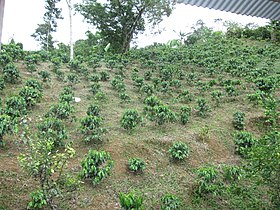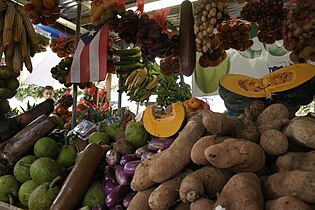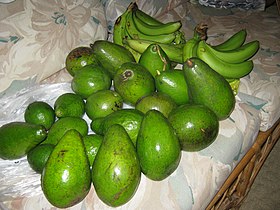| Part of a series on the |
| Economy of Puerto Rico |
|---|
| History |
| Primary sectors |
| Secondary sectors |
| Tertiary sectors |
| Entertainment |
| Companies |
| Government |
| Agencies |
| Assets |
| Bond issuers |
| Public debt |
| Taxes |
| Trade associations |
The agriculture industry in Puerto Rico constitutes over $800 million or about 0.69% of the island's gross domestic product (GDP) in 2020. Currently the sector accounts for 15% of the food consumed locally. Experts from the University of Puerto Rico argued that these crops could cover approximately 30% of the local demand, particularly that of smaller vegetables such as tomatoes, lettuce, etc. and several kinds of tubers that are currently being imported. The existence of a thriving agricultural economy has been prevented due to a shift in priorities towards industrialization, bureaucratization, mismanagement of terrains, lack of alternative methods and a deficient workforce. Its geographical location within the Caribbean exacerbates these issues, making the scarce existing crops propense to the devastating effects of Atlantic hurricanes.
History

Agriculture or farming is concerned with the cultivation of plants, animals and other food sources that sustain life. It also involves growing crops for other purposes. Coffee and sugar cane production in Puerto Rico has had a history of ups and downs, affected by hurricanes and by its isolated location, and its political status as a colony of Spain and of the United States.
In 1900, the most important agricultural products in Puerto Rico were "cotton, rice, cacao, corn, coconuts, pepper, bananas, tobacco, vegetable dyes, coffee, sugar, pineapples and vanilla".

The impact in August 1899 of two hurricanes severely affected the island. The 1899 San Ciriaco hurricane on August 8, and an unnamed hurricane on August 22 killed approximately 3,400 people and left thousands without shelter, food, or work. The hurricanes cost the economy millions of dollars due to the destruction of the majority of the sugar and coffee plantations. Afterwards, nearly 5‚000 Puerto Ricans migrated to Hawaii by 1910 to work in the sugar plantations of said state.
In the 1940s and 1950s agriculture continued to play a crucial role in the island's economy with 45% of the labor force employed within the sector in 1940. The cultivation of pineapples was significant until the 1990s when the main buyer Lotus juice company closed.
In 2012, there were 13,159 farms in Puerto Rico. While not a state, Puerto Rico is a member of the Southern United States Trade Association, a non-profit organization that assists the agriculture industry in developing its exports. In early 2020, farm owners in Ponce reported on the continuing challenge of finding laborers.
New farms
As a result of the 2009 economic crisis and the susceptibility of Puerto Rico to hurricanes, there's been an urgency to push for more farms on the island. While not large enough to produce on a mass scale, the quality of products is high. Farming has a more positive image among young people in Puerto Rico, however, in places like Ponce, where the weather tends to be hotter, farm owners complain that the turnover rate is too high.
In September 2019, an initiative to diminish the amount of coffee that is imported to Puerto Rico was announced by the Hispanic Federation, leading 1,500 Puerto Rico coffee growers.
Crops
Corn (maize) is commonly grown here, including strains of Bt corn producing the Cry1F endotoxin. This has produced extensive Cry1F resistance. One important pest this protects against is the Fall Armyworm (FAW, Spodoptera frugiperda), including Cry1F-resistant FAW. In 2007 Cry1F resistance in FAW was confirmed here and Dow and Pioneer withdrew their Cry1F corn – Herculex I, released in 2003 – from use here. Nonetheless as of 2018 other Cry1F corns are still commonly grown here.
By contrast Storer et al., 2012 notes no such resistance from the mainland of the United States (up to their publication), showing a lack of movement of FAW from here to there. Then in 2014 Huang et al. found alleles that are shared with FAW populations on the US mainland. Due to this history of detections, migration from PR is probably the source of Cry1F-resistance FAW there and not the other way around. On the other hand Banerjee et al., 2017 finds Cry1F-r in Puerto Rico is commonly caused by a particular mutation in SfABCC2, the resistance allele SfABCC2mut. SfABCC2 is the FAW version of multidrug resistance-associated protein 2 (ATP Binding Cassette subfamily C2, ABCC2). They did not find a single such allele in Florida in 2012, 2014, or 2016. These very disparate prevalences fail to support any substantial immigration of FAW from PR to Florida, contrary to earlier studies including Huang above.
The use of two or more effective Cry proteins may be necessary to provide multiple modes of action for resistance management.
Both the Fall Armyworm C-strain and -R-strain are found here, and are shared with Louisiana. These strains were first discovered by Pashley 1986 via a genetic analysis of the PR and La populations, showing segregation on host preference. Both have since been found elsewhere around the world.
Gallery
-
 Mango tree in Rincón
Mango tree in Rincón
-
 In 1941 sugar cane production surged in Río Piedras, now a district of San Juan
In 1941 sugar cane production surged in Río Piedras, now a district of San Juan
-
 Oranges at festival in Maricao
Oranges at festival in Maricao
-
 Preparing to plant in Maricao
Preparing to plant in Maricao
-
 Students plant a tree at a school in Maricao
Students plant a tree at a school in Maricao
-
 Newly planted coffee trees at Hacienda Lealtad in Lares after Hurricane Maria in 2017 destroyed all its coffee trees
Newly planted coffee trees at Hacienda Lealtad in Lares after Hurricane Maria in 2017 destroyed all its coffee trees
-
 Vegetable and fruit stand at Fiesta Acabe del Café in Maricao in 2014
Vegetable and fruit stand at Fiesta Acabe del Café in Maricao in 2014
-
 Avocado harvest in Cayey
Avocado harvest in Cayey
-
 Coffee near Mayagüez in 1899
Coffee near Mayagüez in 1899
See also
References
- "Puerto Rico Fact Sheet per December 2013" (PDF). gdb-pur.com. Retrieved 27 April 2023.
- "Puerto Rico - GDP distribution across economic sectors 2020". Statista. Retrieved 2022-03-18.
- Ramos Segarra, Christian (2021-04-26). "Con alto potencial la industria del cáñamo" [Hemp industry has high potential]. El Vocero. Retrieved 2022-03-18.
- Salamány, Tatiana Díaz RamosyAdriana De Jesús (2020-05-21). "Múltiples los retos de la agricultura para alimentar en tiempos de crisis" [Multiple challenges of the agriculture sector to feed (the people) in times of crisis]. Centro de Periodismo Investigativo (in Spanish). Retrieved 2022-03-18.
- Herrmann, Karl Stephen (1900). From Yauco to Las Marias: Being a Story of the Recent Campaign in Western Puerto Rico by the Independent Regular Brigade, Under Command of Brigadier-General Schwan. R. G. Badger & Company. p. 95. Retrieved 12 October 2019.
- "Hurricane San Ciriaco". Library of Congress. Retrieved March 26, 2006.
- Ayala, Israel Meléndez; Kennedy, Alicia; Winter, Damon (2021-10-04). "Así es como Estados Unidos controla lo que se come en Puerto Rico" [This is how the United States controls what is eaten in Puerto Rico]. The New York Times (in Spanish). ISSN 0362-4331. Retrieved 2022-03-17.
- VOCERO, Fernando Pereira, Especial para EL (2019-03-19). "Piña manatieña busca ser protagonista" [Manatí Pineapple looks to be protagonist]. El Vocero (in Spanish). Archived from the original on 2021-06-24. Retrieved 2021-06-18.
{{cite web}}: CS1 maint: multiple names: authors list (link) - "2012 Census of Agriculture Highlights" (PDF). USDA. USDA. Retrieved 27 August 2019.
- "Puerto Rico Department of Agriculture". www.susta.org.
- ^ "Persiste la escasez de mano de obra en el suroeste" [Labor shortage persists in the southwest]. El Nuevo Dia. 2020-02-01. Archived from the original on 2020-02-01. Retrieved 2020-02-01.
- "'The push we needed': Puerto Rico's local farmers step up efforts after Hurricane Maria". NBC News.
- Graf, Carly. "Meet the Farmers Reclaiming Puerto Rico's Agricultural History" – via www.yesmagazine.org.
{{cite journal}}: Cite journal requires|journal=(help) - "How Puerto Rico Lost Its Home-Grown Food, But Might Find It Again". NPR. Archived from the original on 2017-05-14.
- "Hispanic Federation lidera potente alianza por el café" [Hispanic Federation leads strong coffee alliance]. El Nuevo Dia. 2019-09-13. Archived from the original on 2022-01-11.
- ^
- • Tabashnik, Bruce E.; Carrière, Yves (2017). "Surge in insect resistance to transgenic crops and prospects for sustainability". Nature Biotechnology. 35 (10). Nature Portfolio: 926–935. doi:10.1038/nbt.3974. ISSN 1087-0156. PMID 29020006. S2CID 2882631.
- • Chakroun, Maissa; Banyuls, Núria; Bel, Yolanda; Escriche, Baltasar; Ferré, Juan (2016). "Bacterial Vegetative Insecticidal Proteins (Vip) from Entomopathogenic Bacteria". Microbiology and Molecular Biology Reviews. 80 (2). American Society for Microbiology: 329–350. doi:10.1128/mmbr.00060-15. ISSN 1092-2172. PMC 4867366. PMID 26935135. S2CID 38268030.
- • Prasanna, B. M.; Huesing, J. E.; Eddy, R.; Peschke, V. M. (2018-01-30), Fall Armyworm in Africa: A Guide for Integrated Pest Management, USAID & CIMMYT, hdl:10883/19204, S2CID 90981205
- • Huang, Fangneng; Qureshi, Jawwad A.; Meagher, Robert L.; Reisig, Dominic D.; Head, Graham P.; Andow, David A.; Ni, Xinzi; Kerns, David; Buntin, G. David; Niu, Ying; Yang, Fei; Dangal, Vikash (2014). "Cry1F Resistance in Fall Armyworm Spodoptera frugiperda: Single Gene versus Pyramided Bt Maize". PLoS ONE. 9 (11). Public Library of Science: e112958. Bibcode:2014PLoSO...9k2958H. doi:10.1371/journal.pone.0112958. ISSN 1932-6203. PMC 4234506. PMID 25401494. S2CID 4578967.
- ^
- • Storer, Nicholas P.; Kubiszak, Mary E.; King, J. Ed; Thompson, Gary D.; Santos, Antonio Cesar (2012). "Status of resistance to Bt maize in Spodoptera frugiperda: Lessons from Puerto Rico". Journal of Invertebrate Pathology. 110 (3). Academic Press (Elsevier, Society for Invertebrate Pathology): 294–300. doi:10.1016/j.jip.2012.04.007. PMID 22537834. S2CID 20078891.
- • Tabashnik, Bruce E.; Brévault, Thierry; Carrière, Yves (2013). "Insect resistance to Bt crops: lessons from the first billion acres". Nature Biotechnology. 31 (6). Nature Portfolio: 510–521. doi:10.1038/nbt.2597. ISSN 1087-0156. PMID 23752438. S2CID 205278530.
- • Tabashnik, Bruce E.; Carrière, Yves (2017). "Surge in insect resistance to transgenic crops and prospects for sustainability". Nature Biotechnology. 35 (10). Nature Portfolio: 926–935. doi:10.1038/nbt.3974. ISSN 1087-0156. PMID 29020006. S2CID 2882631.
- • Tabashnik, Bruce E.; Mota-Sanchez, David; Whalon, Mark E.; Hollingworth, Robert M.; Carrière, Yves (2014). "Defining Terms for Proactive Management of Resistance to Bt Crops and Pesticides". Journal of Economic Entomology. 107 (2). Oxford University Press (Entomological Society of America): 496–507. doi:10.1603/ec13458. ISSN 0022-0493. PMID 24772527. S2CID 11761620.
- • Harrison, Rhett D.; Thierfelder, Christian; Baudron, Frédéric; Chinwada, Peter; Midega, Charles; Schaffner, Urs; van den Berg, Johnnie (2019). "Agro-ecological options for fall armyworm (Spodoptera frugiperda JE Smith) management: Providing low-cost, smallholder friendly solutions to an invasive pest". Journal of Environmental Management. 243. Elsevier: 318–330. doi:10.1016/j.jenvman.2019.05.011. hdl:10394/32572. ISSN 0301-4797. PMID 31102899. S2CID 158047487.
- • Dhadialla, Tarlochan S.; Gill, Sarjeet S. (2014). Insect Midgut and Insecticidal Proteins. Advances in Insect Physiology. Vol. 47. London, England: Elsevier. doi:10.1016/c2013-0-12819-x. ISBN 978-0-12-800197-4. ISSN 0065-2806. OCLC 891383494.
- ^
- • Tay, Wee Tek; Gordon, Karl Heinrich Julius (2019). "Going global – genomic insights into insect invasions". Current Opinion in Insect Science. 31. Elsevier: 123–130. doi:10.1016/j.cois.2018.12.002. ISSN 2214-5745. PMID 31109665. S2CID 92033565.
- • Heckel, David G. (2020). "How do toxins from Bacillus thuringiensis kill insects? An evolutionary perspective". Archives of Insect Biochemistry and Physiology. 104 (2). Wiley Publishing: e21673. doi:10.1002/arch.21673. hdl:21.11116/0000-0005-F478-1. ISSN 0739-4462. PMID 32212396. S2CID 214645874.
- • Banerjee, Rahul; Hasler, James; Meagher, Robert; Nagoshi, Rodney; Hietala, Lucas; Huang, Fangneng; Narva, Kenneth; Jurat-Fuentes, Juan Luis (2017). "Mechanism and DNA-based detection of field-evolved resistance to transgenic Bt corn in fall armyworm (Spodoptera frugiperda)". Scientific Reports. 7 (1). Nature: 10877. Bibcode:2017NatSR...710877B. doi:10.1038/s41598-017-09866-y. ISSN 2045-2322. PMC 5589895. PMID 28883440. S2CID 205594922.
- ^
- • Pashley, Dorothy P. (1986). "Host-associated Genetic Differentiation in Fall Armyworm (Lepidoptera: Noctuidae): a Sibling Species Complex?". Annals of the Entomological Society of America. 79 (6). Oxford University Press (Entomological Society of America): 898–904. doi:10.1093/aesa/79.6.898. ISSN 1938-2901. S2CID 85955655.
- • Drès, Michele; Mallet, James (2002). "Host races in plant–feeding insects and their importance in sympatric speciation". Philosophical Transactions of the Royal Society of London. Series B: Biological Sciences. 357 (1420). The Royal Society: 471–492. doi:10.1098/rstb.2002.1059. ISSN 0962-8436. PMC 1692958. PMID 12028786. S2CID 20976796.
- • Carroll, Scott P.; Boyd, Christin (1992). "Host Race Radiation in the Soapberry Bug- Natural History with the History". Evolution. 46 (4). Wiley Publishing (Society for the Study of Evolution): 1052–1069. doi:10.1111/j.1558-5646.1992.tb00619.x. ISSN 0014-3820. PMID 28564420. S2CID 42632200.
- • Nagoshi, Rod N.; Meagher, Robert L. (2004). "Behavior and Distribution of the Two Fall Armyworm Host Strains in Florida". Florida Entomologist. 87 (4). Florida Entomological Society: 440–449. doi:10.1653/0015-4040(2004)087[0440:badott]2.0.co;2. ISSN 0015-4040. S2CID 55750270.
Further reading
- Report of the Puerto Rico Agricultural Experiment Station. U.S. Government Printing Office. 1914. Retrieved 12 October 2019.
External links
| Agriculture in North America | |
|---|---|
| Sovereign states | |
| Dependencies and other territories | |
